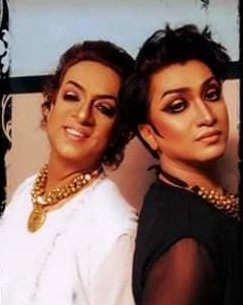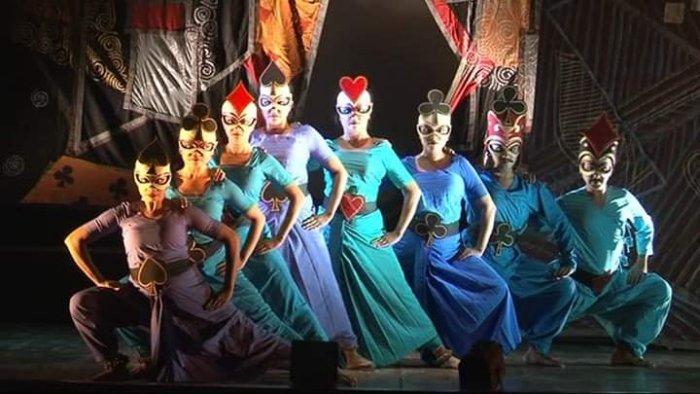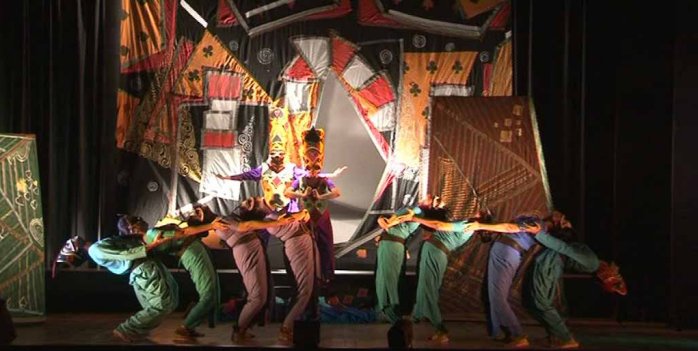
|   |

|   |
|
85th birth anniversary of Dr. Manjusri Chaki Sircar at Kolkata - Nita Vidyarthi e-mail: nitavidyarthi@gmail.com Photos courtesy: Parbati Gupta October 15, 2019 To commemorate the 85th birth anniversary of the acclaimed dancer, the late Dr. Manjusri Chaki Sircar on the 29th of August, Dancers' Guild, presented an evening of dance at the Sisir Mancha, Kolkata. Chaki's dance style and her 'Navanritya' methodology did not adopt the different dance forms, be it Indian classical or otherwise, but it was a manifestation of how the body consciously negotiated and processed the various cultural forms thereby becoming a significant form of representational practice which was universal. This was her Navanritya which was again a result of her international journeys and lived experiences in Africa and North America. They looked familiar but yet were entirely different. What was evident in the style was its taut integration of the body movements and its freedom which gave it a picturesque morphing fluidity. She freed the Indian classical forms and gave it breadth and scope, well noticeable in the Guild's evening production 'Kon Nutaner Dak.' As mentioned by scholar-dancer Aishika Chakravarty, 'Navanritya,' a psycho-physical exercise is a movement and not really a vocabulary or dance form.  Dosor The theme was real. In the life's journey one tends to neglect the mind and its unspoken injuries, emotions and damages by superimposing it with an artificial external self which is in constant conflict with the inner one that complement each other. Dosar displays this tussle with a set of dancers moving with intertwining strong movements at the rear of the stage while Drabin Chatterjee, the assistant dance director, disciple of Kohinoor and dress designer, clad in black portrays the agonized self. Kohinoor Sen Barat in shimmering white flowing dress calms and comforts the perturbed Drabin, his 'Dosor' with soothing hand movements. The concept by Pokhraj Chakravarty was ambiguous, perhaps newly interpreted and often perplexing, forcing the viewer to wander along different lines of ambivalent human behaviour, and self. The dancing in duet at times was too passionate with emotional torrent and Drabin's "shimmy" was uncomfortable to the eyes of many in the audience including this reviewer. Undoubtedly both were very skilled dancers but the set design of a worn-out picture of a woman, tarnished mirror, an old chair and semi-darkness throughout the 40minute presentation, all spoke of morbidity or a full- moon show. It could have been worked upon better on a different level to impart sunshine and positivity! A breath of fresh air came in with the Dancers' Guild representation of Tagore's most sought after dance drama 'Tasher Desh,' The Kingdom of Cards, in their production 'Kon Nutaner Dak' named after picking up the line of a song from the dance drama. The production is a familiar tale full of sharp satire, dealing with rigid discipline and autocracy, refreshingly presented with marvellous choreography blending the contemporary and classical forms with stretched imagination of the choreographers Dr. Manjusri Chaki Sircar and Ranjabati Sircar. The Prince and the merchant's son on a pleasure voyage get caught in a storm and land up in an unknown land - The Kingdom of Cards - where creatures resembling human beings move in a weird way. They are arrested and brought to the court where everyone follows a set of rules "Niyom" to live their lives. The duo frees them from their restricted, suffocating lives by offering all, including the King, the taste of freedom.  Tasher Desh  King's court in Tasher Desh This contemporary performance showcased the number of ways the classical dance forms like Manipuri, Bharatanatyam and to some extent Kathak can be reinvented and reinterpreted by overcoming their limitations to result in a fascinating movement offering. The march of the card soldiers set to the song "Aamra chitra, ati bichitra" (We are colourful and weird) was a consorted forward movement by the dancers with heavy ankle bells, executing tatkaar with a deep araimandi. Not only the creative process of transformation but also the overall presentation by minimal deconstruction was intelligent, artistic and new. Another excellent visual imagery was the rolling of waves in the turbulent sea, picturised by three lines of dancers lying linearly straight on the ground, moving in tandam with perfect clockwise precision rolling with the music when, with a forceful splash falls the Prince and the merchant's son in the sea. Rabishankar Roy as the Prince and Swadhin Sen as the merchant's son stand out for their excellent rendition, strength and grace. The physical fitness of the group dancers, a result of rigorous training in the Guild, provided an unusual, dynamic setting for the high energy blend of authentic and contemporary, ensuring a performance that is simply outstanding, uplifting dance. The production had totally done away with signs as is normally the case with other productions of Tasher Desh. Instead they used masks and a motif of the particular card and an innovative patchwork backdrop. The discipline, physical fitness and power of the dancers were remarkable and the creative process more personal, artistic interpretation of the story of movements. The dance direction by Jonaki Sarkar established the right mood at the right places of the piece with the collection of movements from the Sircars' choreography making it aesthetically complete. A remarkable feature of the choreography was the incorporation of controlled Kalaripayattu movements and kicks blended with wonderful body movements of the Rajputra (Prince) and his friend Saudagar Putra (merchant's son). Renowned supports made the production spellbinding. Music direction was by Subhash Chowdhury, and music composition by Swapan Pakrashi. Translation of a few songs was by none other than William Radice and the stunning imaginative and unusual stage props by Sanchayan and Tuhin Ghosh with fantastic light design by Sasanka Mondal. The credit for the special masks goes to Swapna Ghosh and Parbati Gupta must be praised for the overall management. 'Kon Nutaner Dak' was a shifting world of dazzling imagery. The topping of the cake was a request by Sri Chandradoy Ghosh, the Secretary of the West Bengal Dance Group Federation, for a repeat performance of the production, to Mr. Gautam Dey, the Regional Director of ICCR, Kolkata, at Rabindranath Tagore Centre, Kolkata. Dr. Nita Vidyarthi is a veteran critic of performing arts and writes on dance, music and theatre in leading publications. |